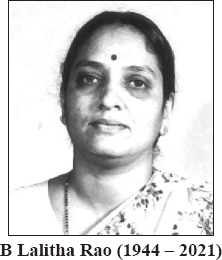Translate this page into:
Obituary
*For correspondence: shaileshpawarniv@gmail.com
-
Received: ,
This article was originally published by Wolters Kluwer - Medknow and was migrated to Scientific Scholar after the change of Publisher.

- B Lalitha Rao (1944 – 2021)
Dr B Lalitha Rao was born in 1944 in Sagar, Shivamogga (Shimoga) district, Karnataka State. She completed her MBBS degree and joined the Indian Council of Medical Research-National Institute of Virology (ICMR-NIV) in 1970 as a research officer. Later, she earned a higher degree of M.D. in Microbiology from the Savitribai Phule Pune University, Pune. Dr Rao retired from ICMR-NIV in September 2004, after 34 years of service as Deputy Director (Senior Grade). She breathed her last on June 21, 2021. Throughout her journey, she played a pivotal role in establishing the discipline of influenza at ICMR-NIV.
India experienced influenza pandemics in 1918, 1957, 1968, 1978, and 2009, and suffered severely during the latter half of the 1918 influenza A (H1N1) pandemic. The 1921 Census report estimated 12-13 million deaths for India as a whole, in a period of three to four months.
Taking into consideration the pandemic potential of influenza and the crucial role of early detection of influenza strains for prevention and control, Dr Rao initiated work on influenza surveillance at ICMR-NIV. The influenza division at ICMR-NIV was recognized as the National Influenza Centre by the World Health Organization (WHO) in 1976.
During the period 1976–2005 several outbreaks of influenza were investigated by the National Influenza Centre under her leadership. The information available on the seasonality of influenza in tropical countries was scanty. Her studies established that in Pune, which has a tropical monsoon climate, influenza outbreaks occurred predominantly during the rainy season. More than 500 isolates comprising 50 antigenic variants of A(H1N1), A(H3N2), and type B were isolated, typed and shared with the WHO Global Network for influenza surveillance. The three types and subtypes circulated singly or in different combinations during these outbreaks, which included several important global strains causing extensive epidemics. Her studies indicated that influenza A(H3N2) subtype was predominant in Pune, during the years 1990 to 2000 followed by influenza A(H1N1) strain, after a gap of 10 years. The isolation and identification of the circulating influenza virus strains played an important role in updating the annual influenza virus vaccine strain recommendations by the WHO.
Along with virus isolation studies, serological surveys were also conducted periodically in 1984, 1999 and in 2001 in Pune to determine the immune status against the pandemic and epidemics strains of influenza. The results indicated broadening of antibody response to a greater number of strains with advancing age. Serological diagnosis of influenza A(H3N2) and type B strains in patients of Reye’s syndrome during the two influenza outbreaks, highlighted its role in neurological complications.
Prevalence of influenza viruses in domesticated animals like pigs, horses, and poultry present high risk of introduction of new influenza subtypes in humans. Dr Rao conducted serological and virological investigations in birds and animals from Pune and other parts of India in 1978. During this study influenza A H4 subtype was isolated from the cloacal swab of a domestic duck, highlighting the need for avian influenza surveillance in wild, resident, migratory birds, and poultry. The studies on pig serum samples collected between 1968-1988 from different States of India (Tamil Nadu, Andhra Pradesh, Maharashtra, West Bengal, and Andaman and Nicobar islands) demonstrated the prevalence of antibodies to human A(H3N2) and A(H1N1) strains. Serological survey of equines from Pune between 1987 and 1989 showed the prevalence of antibodies to equine influenza A(H7N7) and A(H3N8) strains. The study on dog serum samples showed the prevalence of antibodies to human A(H3N2) strain and bat serum to human A(H1N1) strain. These studies indicated her vision to study infectious diseases at the human-animal interface.
Dr Rao took keen interest in studying other respiratory viruses such as the human respiratory syncytial virus (hRSV), adenoviruses and metapneumovirus. Several strains of the hRSV and adenoviruses were isolated from paediatric patients with acute respiratory disease. Her work on the investigation of a large outbreak of acute encephalitis with high fatality rate in children in Andhra Pradesh, India, in 2003, associated with the Chandipura virus may be one of the best examples of the investigation of an emerging virus.
Considering the pandemic potential of highly pathogenic avian influenza H5N1 virus and as a part of the pandemic preparedness in India, the ICMR in collaboration with the Centres for Disease Control and Prevention, USA, established multi-site influenza surveillance studies in 2004. Her protocols, reports and studies on influenza became the basis for the establishment of a harmonized reporting system in the multi-site studies on influenza in India. This network played a very important role in the mitigation of the influenza pandemic caused by the H1N1 virus in 2009.
In addition to her scientific achievements, she took great interest in poetry and her poem ‘The Viruses Speak’ explaining the properties of different viruses, not only educates, but also amuses children, adults, biologists and laymen alike. It highlights her deep understanding in the discipline of virology. She was a kind-hearted person which is aptly reflected in her poem ‘The Beautiful Tree’ that was dedicated to a magnificent tree that stood at the entrance of the ICMR-NIV, which unfortunately collapsed during one of the storms. She took the initiative to plant another tree at the same place displaying her sensitivity towards nature. She wrote a number of poetry books in her mother tongue Kannada and also released audio cassettes of her poems. She is survived by a son, daughter and grandchildren. She will be fondly remembered for her contribution in the field of influenza research in India.





